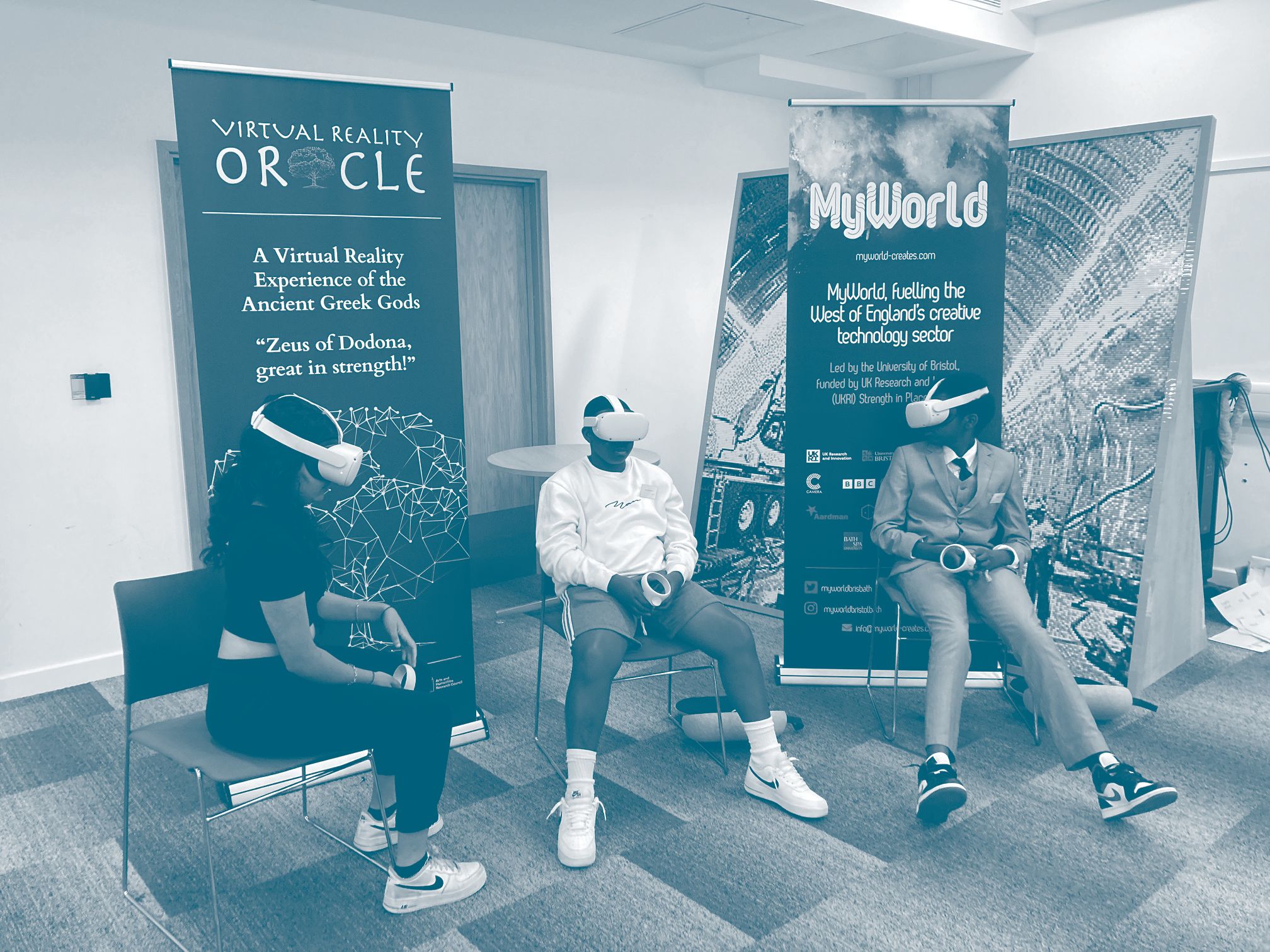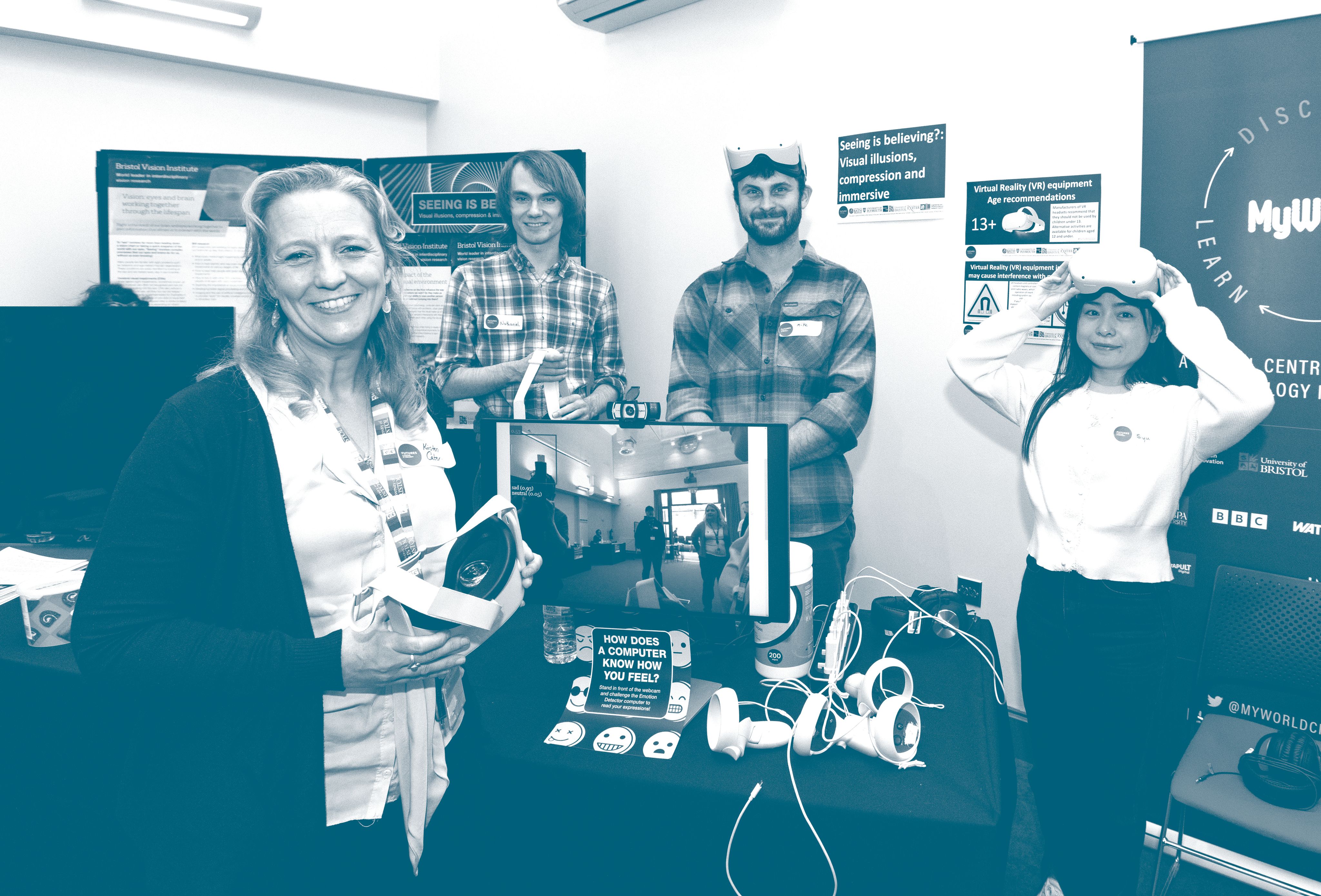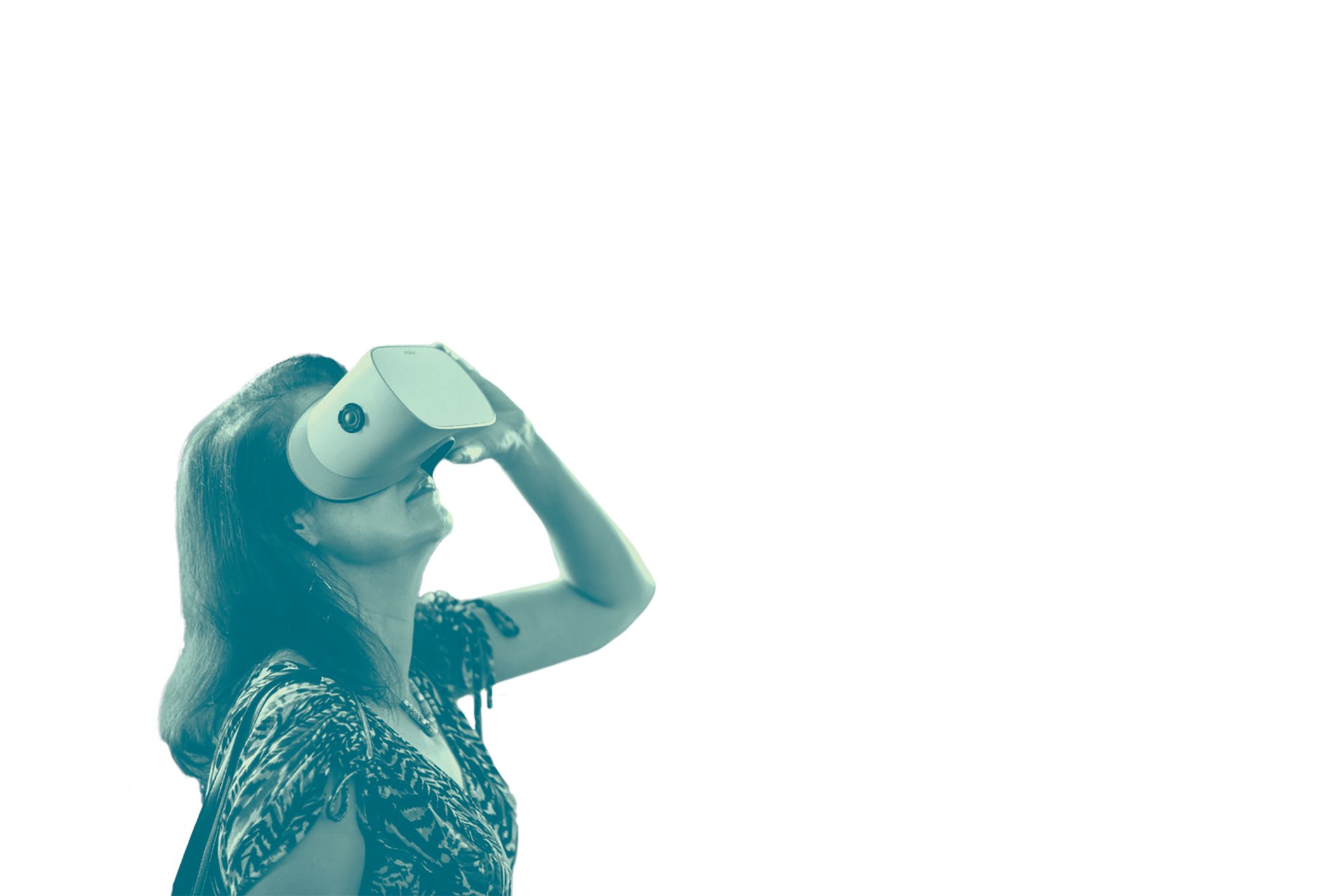Reshaping our Digital Experience

Is it possible for tech to truly be a force for good, when most of us – and particularly the most marginalised in society – have no say in how it is created and used in our world? Bristol academic Professor Kirsten Cater (BSc 2000, PhD 2004) has spent her career exploring how technology can enhance our experiences and interactions with each other and the world around us through a collaborative and transdisciplinary approach.
Technology and innovation mean very different things to different people and each individual’s relationship with technology is as complex and nuanced as they are. For some people, technology is freeing, transformative and even life affirming. Not to mention lucrative. For others, it’s simply a necessary part of a daily routine to keep on top of, so as not to fall behind in life and work. Yet, for a still quite sizeable group, technology remains scary, intimidating and excluding. It’s a barrier in the way of them accessing services and opportunities, thereby increasing their social isolation and marginalisation and ultimately contributing to what some refer to as the digital divide.
As a computer scientist, I’ve always been interested in innovation and technology, but it’s people that really fascinate me. As Professor of Human Computer Interaction, I’m able to combine these interests. First, I try and understand what the frustrations and challenges are that people are trying to deal with. Then I ask: can I work in a collaborative and transdisciplinary manner with the end user to come up with a technological solution that might enhance their experience and ultimately make their life better?
'It’s important to acknowledge that we are still at the dawn of the digital age’
With that said, I don’t think we should be beholden to technology or obligated to use it for the sake of using it. A pen and paper might still be the best option in certain instances. Technology can also be more than just simply an unwanted distraction: sometimes it can be actively harmful. We all know about the demonstrable damage that social media can have on young people’s mental health. Closer to my own research in immersive technologies, there have also been recent worrying reports of sexual assaults within metaverse platforms. This has focused my mind, along with many others in the research community, on potential future harms of cutting-edge technologies.
I don’t believe companies actively set out to build poorly implemented or harmful solutions. But sometimes, the way that technologies and solutions are developed, through an uncollaborative, non-diverse and siloed manner, can ‘bake in’ unintended consequences and biases. These range from usability and access issues to full-on discrimination. We will never be able to completely eliminate risk when developing solutions that are truly innovative. That’s the nature of innovation: it’s a risky business. But I believe an important step is to embed collaboration and diverse and transdisciplinary thinking into research, innovation and education from the very outset.
Year 10 students enjoying virtual reality as part of an Engineering Work Experience session. Photography: Jo Gildersleve. Main photograph above: Dr Pui Anantrasirichai.
Year 10 students enjoying virtual reality as part of an Engineering Work Experience session. Photography: Jo Gildersleve. Main photograph above: Dr Pui Anantrasirichai.
Here at Bristol, we work with as many stakeholders as we can, including industry, government, startups, community groups and the public. We empower them with the skills to conduct research with us, giving them a voice in shaping how the research is explored and conducted, and determining what outcomes are valuable to them – instead of simply testing with targeted users at the very end of the technological design process, as sometimes happens.
It’s also important to consider how to make solutions sustainable and scalable. There’s no use designing a high-end experience that’s only accessible to a select few for a short period of time. If it’s going to have long-term impact, post-research funding, we also need to consider all our stakeholders and their interests. For example, who will fund its upkeep and maintain it; how will those from diverse and underrepresented backgrounds access these cutting-edge technologies; and how can we train them to use and develop these technologies further?
Those sorts of questions were front of mind in our work with the UK Hydrographic Office on improving safety at sea and explored how augmented reality could be used on ships, through Innovate UK funding. When we began the project there was a pivot towards digital systems in the maritime sector, but there remained a heavy reliance and trust in printed materials such as large physical maps for navigation and huge volumes of data books. My team spent a lot of time doing ethnography studies with the different stakeholders to begin with, interviewing and observing everyone on the ship including all the various ranks, to understand their roles and where technology could help them. One system we worked on was for the entry into port, replacing numerous pieces of information and calculations around weather, tide and load with data visualisations on mobile devices, which responded in real time to changing scenarios.
We’ve recently finished a project called the Virtual Reality (VR) Oracle, funded by the Arts and Humanities Research Council, to understand how immersive technologies could be utilised in education. As part of a wider revamp of the curriculum for Classical Studies at A-level, we looked at the concept of visiting an oracle, which in ancient Greece was used to guide decisions, ranging from whether to wage military campaigns through to the suitability of marriage proposals. I think that’s quite a difficult concept for Gen Z students to grasp, as most of their life they have always simply Googled any questions they have. Working closely with teachers and students, alongside experts in ancient Greek religion, we developed an immersive experience together to support a more engaging and richer understanding for students about how oracle consultations might have been performed.
We’re also working on several projects exploring the use of immersive technologies in healthcare, involving medical practitioners and patients as co-designers. Virtual reality (VR) has already been shown to have great potential in this sector, with particular success in surgical training, psychotherapy, rehabilitation, as a distraction tool, as well as providing a new medium to tell firsthand stories of patients’ medical journeys. Through our EPSRC-funded project Virtual Realities: Immersive Documentary Encounters, we worked with breast cancer patient Victoria Mapplebeck as a producer, to tell her own intimate journey of her diagnosis through treatment to recovery and its transformative impact on the body and family life. The resulting VR production, Waiting Room, went on to premiere at Venice Film Festival in 2019 and was listed in Forbes’ ‘Top 50 XR Experiences of 2019’.
Professor Cater and team at their ‘Seeing is Believing’ stand at FUTURES 2023, a festival celebrating research and innovation. Photography: Jon Rowley
Professor Cater and team at their ‘Seeing is Believing’ stand at FUTURES 2023, a festival celebrating research and innovation. Photography: Jon Rowley
The kind of transdisciplinary and collaborative thinking that is a hallmark of our research should, I believe, begin at undergraduate level, so we can equip innovators of the future to create technologies that better serve our society. That’s why I established the multi-award-winning Centre for Innovation and Entrepreneurship at the University in 2016. The Centre’s four-year master’s programme for undergraduates is split between students’ main subject (14 in total, including History, Physics and Theatre) and the study and practice of Innovation. It remains vitally important that they continue to be trained in depth in their respective disciplines; that’s where they become disciplinary experts. But they then bring that disciplinary expertise and unique way of looking at a problem to the table, working with people from other disciplines who think differently to them to devise innovative solutions to complex challenges, merging their different perspectives to construct new knowledge and new ways of looking at a problem. Crucially, they learn about human-centred design, how to work collaboratively with each other and their stakeholders, and not to be afraid of failure. To be innovative, you must take risks, push technology boundaries and make mistakes. It is how quickly you learn from those mistakes and failures that will determine whether you will be a successful innovator or not.
Participant at VR100, an immersive theatre performance at Kilter Theatre. Photography: Benjamin Pryor
Participant at VR100, an immersive theatre performance at Kilter Theatre. Photography: Benjamin Pryor
Arguably, just as important as our entrepreneurs are our graduating ‘intrapreneurs’ who go into a whole range of different organisations and bring those innovative practices with them to try and change culture and mindset from within. There’s a lot of discussion right now around skills for the future. The World Economic Forum predicts in their 2023 report that almost a quarter of jobs (23%) are expected to change in the next five years. A lot of people are worried about technology taking their jobs and them being left unemployed, but I think that’s overstated. Yes, technologies such as robotics and artificial intelligence will replace certain jobs (including some that are dangerous) but there will also be new jobs created, working closely with these cutting-edge technologies. Importantly, I think we’ll always want a ‘human in the loop’ for ethical and safety reasons. As a consequence, the challenge then arises how we train our workforces to embrace new technological skills and ensure those skills are given to a workforce that is truly diverse. As part of our UKRI-funded MyWorld project we are training under-represented groups in creative technologies. We hope that opportunities like these will open up different career paths for diverse groups of people who might not necessarily have considered working with cutting-edge technologies in the past.
Looking to the future, it’s also really important that we proactively get ahead of the curve in terms of understanding the potential ethical and sociodigital dilemmas that future technologies might throw up, rather than desperately scrambling to react to them as they arise. Through the ESRC-funded Centre for Sociodigital Futures we bring together world-leading disciplinary expertise to explore sociodigital futures in a collaborative and transdisciplinary manner. For example, in a world where you can glean an awful lot about who a person is from their data, could you or should you recreate that person in VR and have them ‘living’ post-humanly after they’ve passed away? We’ve explored that question, and engendered open debate, through a design fiction collaboration with Kilter Theatre.
Overall, it’s important to acknowledge that we are still at the dawn of the digital age. We’ve only seen a fraction of the future potential benefits of technology – and some would argue mere glimpses into the possible harms. But I believe with a human-centred, transdisciplinary and collaborative approach there’s every reason to be hopeful that we can create a brighter technological tomorrow together.
Professor Cater has received funding from UK Research and Innovation (UKRI); Innovate UK; Economic and Social Science Research Council (ESRC); Engineering and Physical Sciences Research Council (EPSRC).


